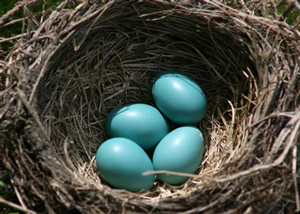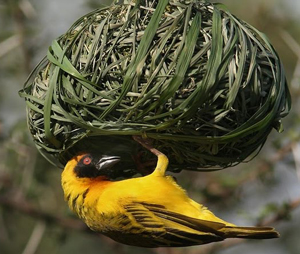All flying animals don't make nests; for example, some waterfowl and a few land avifauna lay little oval reproductive elements on bare rocks of ledges that project out from the face of a cliff near oceans.
Other species of the feathered vertebrates of the class of Aves, or birds, that live in sandy areas make little or no preparation for any nests; instead, they make bowl-shaped places in the sand where they lay their eggs and after the little ones hatch, the adults feed and protect them.

This is just one example of the kinds of nests made by birds.
Larger fowl; such as, chickens use straw and grass to produce their nests or the human owners provide the material for their nests.
2. A home or house where people live: Jane and Bob live in their little cozy nest in the suburbs.3. A place that is filled with, or frequented by, undesirable people or things: A great deal of news has been focusing on the nests of U.S. spies that have been snooping in various countries.
4. Etymology: from Old English nest, of Germanic origin and related to Latin nidus, "nest".
Two primary elements determining most nest preparations are the types of environments and the kinds of young ones when they arrive from their eggs or at birth are to exist.
Go to this Cliff Swallows of Santee Lakes page so you can see significant information about swallows and their nests.
Near the ocean, there is an area where seagulls are nesting by the hundreds.

Some birds are nesting their places for eggs and chicks in a completely different format as shown in this woven-grass room and board structure.
Karen's little girl has Russian dolls made of wood carvings that nest inside each other.
Rene has sets of bowls in which smaller ones nest inside the larger ones.
The ant carton consists of particles of wood, dry vegetable material, and soil glued together with sugary secretions collected by the ants from aphids and other homopteran insects (bugs that pierce plant tissues and suck out the sap).
The fungal mycelium (loose network of delicate filaments hyphae or threadlike filaments that form the body of a fungus) grows through the walls of the carton which are strengthened by the symbiotic fungus which reinforces them in the same way that steel mesh or rods reinforce the walls of buildings.
Cleptobiosis is a widespread form of competitive exploitation in ants known as "robbing food" or "stealing food".
The architecture of the mound is often elaborate, specific in plan to the species, and evidently adapted to contribute to microclimate control within the dwelling place.
It is possible that the nest odor is the same as the "colony odor" in some cases. The nest odor of honey bees is often referred to as the "hive aura" or "hive odor".
